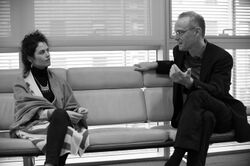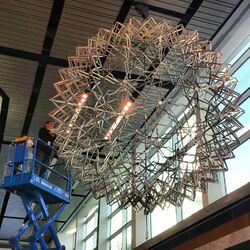Biography:Chuck Hoberman
Chuck Hoberman (born 1956 in Cambridge, Massachusetts, US) is an artist, engineer, architect, and inventor of folding toys and structures, most notably the Hoberman sphere.
Early life and education
Hoberman's father was an architect, and his mother was a children's book author.[1] He wanted to be an artist from an early age, doing drawing and painting, and eventually taking courses at Cooper Union in New York City . He studied liberal arts at Brown University, and went on to earn a bachelor's degree in sculpture from Cooper Union in 1979, and a master's degree in engineering from Columbia University. At some point during his education, he was asked to produce a sculpture that could move. He made a work that unrolled colored plastic sheets on the floor, and he became fascinated with kinetic art.[1] Finishing his formal education, he then went to work for a robotics engineering firm, where he added computer modeling (CAD-CAM) to his skills.[1] After six years, he left to pursue his artistic and technical interests full-time.
Temporary and permanent installations
The second largest Hoberman sphere is displayed at Liberty Science Center in Jersey City, New Jersey, in an atrium where it periodically contracts and then expands to a diameter of 18 feet (5.5 m).
Hoberman also has designed folding architectural structures like the Expanding Hypar (1997) at the California Museum of Science and Industry; the Hoberman Arch, the centerpiece of the medals plaza for the 2002 Salt Lake City Olympics; and a retractable dome featured at the World's Fair 2000 in Hanover, Germany. His artwork has been exhibited at international museums including the New York's Museum of Modern Art, the Centre Georges Pompidou in Paris, and the Mycal Otaru Bay in Hokkaidō, Japan .
Hoberman has installed permanent building facades that transform in transparency at the Wyss Institute for Biologically Inspired Engineering of Harvard University and the Simons Center for Geometry and Physics at SUNY Stony Brook.[2]
In July 2011, the rock band U2 concluded a nearly three-year world-wide concert tour (called "360°") that featured Hoberman's expanding video screen, a 3,800 square feet (350 m2) elliptical display that would grow into a seven-story cone. The display weighed 120,000 pounds (54,000 kg), and incorporated 888 LED screens displaying a total of 500,000 pixels. The complex apparatus was successfully transported and reassembled for 110 concerts during that time.[2]
Toys
In addition to toys such as the Hoberman sphere, Hoberman created the BrainTwist, a hard plastic tetrahedron that folds, stellates, and becomes self-dual while having a component that rotates similarly to a Rubik's Cube. Likewise, Chuck Hoberman's Pocket Flight Ring is a folding, throwable toy resembling a chakram. Hoberman has also created the Expandagon Construction System, a kind of construction toy.
Business
In 1990, he formed Hoberman Associates. In 1995, he co-founded Hoberman Designs with his wife and business partner, Carolyn Hoberman.
Teaching
In the Fall 2012 term at the Harvard Graduate School of Design, Hoberman led "Transformable Design Methods", a hands-on design course. Three-person student teams devised transformable structures under Hoberman's guidance, which were exhibited publicly in early 2013.[3][4]
In the Spring 2013 term at the Massachusetts Institute of Technology, Hoberman co-taught a course with MIT professors Erik Demaine and Daniela Rus called "6.S080: Mechanical Invention through Computation". Student teams built transformable structures, including scale models and a full-sized reconfigurable table, which were exhibited in mid-2013.[5][6]
Awards and honors
In 1994, the Museum of Modern Art added the Hoberman sphere into its permanent collection.[7]Hoberman won the Chrysler Design Award for Innovation and Design in 1997 and was a finalist for the 2000 Smithsonian National Design Award.
Patents
Hoberman has been granted numerous US and foreign patents including for:
- Reversibly expandable doubly-curved truss structure [8]
- Radial expansion/retraction truss structures [9]
- Curved pleated sheet structures [10]
- Reversibly expandable structures having polygon links [11]
- Continuously rotating mechanisms [12]
- Loop assemblies having a central link [13]
- Retractable structures composed of interlinked panels [14]
- Folding covering panels for expanding structures [15]
- Geared expanding structures [16]
- Synchronized ring linkages [17]
- Transforming puzzle [18]
- Synchronized four-bar linkages [19]
- Panel assemblies for variable shading and ventilation [20]
- Covering structure having links and stepped overlapping panels [21]
- Panel assemblies having controllable surface properties [22]
See also
References
- ↑ 1.0 1.1 1.2 "Chuck Hoberman". Inventor of the Week Archive. Massachusetts Institute of Technology. September 1998. http://web.mit.edu/invent/iow/hoberman.html. Retrieved 2014-04-03.
- ↑ 2.0 2.1 "News". Hoberman: Transformable Design. Hoberman Associates, Inc.. http://hoberman.com/news.html. Retrieved 2014-04-03.
- ↑ "New Generation of Transformable Design: Student work on exhibit at Harvard GSD". Hoberman: Transformable Design. Hoberman Associates, Inc.. February 2013. http://www.hoberman.com/news/article_gsd2013.html. Retrieved 2014-04-03.
- ↑ "Transformable Design Methods". Harvard University Graduate School of Design. President and Fellows of Harvard College. 2013. http://www.gsd.harvard.edu/#/projects/transformable-design-methods.html. Retrieved 2014-04-03.
- ↑ "About". 6.S080: Mechanical Invention through Computation. Massachusetts Institute of Technology. Spring 2013. http://courses.csail.mit.edu/6.S080/. Retrieved 2014-04-03.
- ↑ "Lectures". 6.S080: Mechanical Invention through Computation. Massachusetts Institute of Technology. Spring 2013. http://courses.csail.mit.edu/6.S080/lectures/. Retrieved 2014-04-03.
- ↑ "Hoberman Sphere". The Collection. The Museum of Modern Art. 1994. http://www.moma.org/collection/object.php?object_id=132506. Retrieved 2014-04-03.
- ↑ US patent 4942700
- ↑ US patent 5024031
- ↑ US patent 5234727
- ↑ US patent 6082056
- ↑ US patent 6190231
- ↑ US patent 7100333
- ↑ US patent 6739098
- ↑ US patent 6834465
- ↑ US patent 7464503
- ↑ US patent 7540215
- ↑ US patent 7125015
- ↑ US patent 7644721
- ↑ US patent 7584777
- ↑ US patent 7559174
- ↑ US patent 8615970
External links




